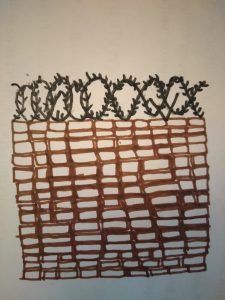The Outlawed Sect
ø

Barbed Wires
Week 11: Creation of Pakistan
Medium: Markers
Title: The Outlawed Sect
In this illustration, I have drawn the wall with barbed wires around my house back in my hometown Lahore, Pakistan. It depicts the outsider status that I, as a member of the Ahmadiyya community, have grown up with. The Ahmadiyya community was outlawed in 1974, under the governance of Zulfiqar Ali Bhutto. The community was constitutionally recognized as non-Muslims and they were not allowed to call themselves Muslims even though they considered themselves Muslims and a sect in Islam. Zulfiqar Ali Bhutto took these steps as a political move to win support of the religious extremists in Pakistan who constituted a large portion of Pakistan. The Ahmadiyya community was seen as outlaws because they believed in a prophet after the Prophet Muhammad, Mirza Ghulam Ahmad Qadiani. The state of religion in Pakistan can be correctly depicted “as a fossilized monolith: Arab, patriarchal, rigid, violent, and utterly at odds with modernity” (Pg 103, Robert Rozenhal, Debating Orthodoxy, Contesting Tradition).
Growing up in Lahore, I experienced persecution from people I called friends. As soon as someone found out that I was a “Marzai” or “Qadiani”, which are derogatory terms used to denote someone who’s an Ahmadi, they would stop being friends with me and call me “Kafir” (Sinner). Mirza Ghulam Ahmad can be categorized as a revivalist who wanted to restore the glory days of Islam and started a movement claiming to be Mahdi or the promised Messiah. “Championing themselves as defenders of God against a corrupt modern world, revivalists promise to restore Islam’s lost glory through a systematic program of social, religious, and political activism” (Pg 113, Robert Rozenhal, Debating Orthodoxy, Contesting Tradition). In class, we have seen the symbols of Avatara being used to talk about the promised Mahdi, and all religious faiths believe in the coming of a Messiah before the end of days. Mirza Ghulam Ahmad claimed the title of Messiah and the second coming of Isa, which all Muslims believe in. However, he was met with fierce resistance especially in Pakistan by religious scholars who denied his claims and called him a false prophet.
On April 26, 1984, in attempts to make Pakistan into an Islamist nation, Zia-ul-Haq, passed an ordinance against Ahmadiis, which prevented them from preaching or professing their beliefs. A blasphemy act was also passed under which anyone saying anything against the Prophet Muhammad, could be killed. In passing this law, the state legitimized the killing of those who did not believe in the finality of Prophet Muhammad, by effectively stating those who did not openly accept the finality of Prophet Muhammad and claimed differently, would have no rights under the state. Since the Ahmadiyya community believed in a prophet after Muhammad, these laws paved the way to state accepted persecution and oppression of the religious minority, the Ahmadiyya community. Under this ordinance, we could not “pose as Muslims”. The barbed wires around my house symbolized the outsider status that we Ahmadis felt, fearing for our protection from religious extremists. Practically, it was meant to prevent anyone from climbing in to the house and openly hurting or killing members of our family. There were instances in which “mullahs” gave sermons outside in a park right next to our house, about how, we Ahmadiis are “Wajabul-Qatl”, meaning that it’s legal and within the teachings of Islam to kill us and that we had no rights. The mullahs would leave stickers on our door, marking us as “Kafirs” and calling on others to stop interacting with us. Another time, someone threw a huge brick into our house garage and fortunately no one got hurt. Things have only gotten worse since then. Imran Khan, the prime minister of Pakistan, who has been ousted out of power, passed laws last year according to which, our state id and passport would now have “Non-Muslim” written over it instead of “Ahmadi”, further stifling our ability to identify as part of the Ahmadiyya community and calling ourselves Muslims. This attitude towards Ahmadis is only specific to Pakistan. In countries other than Pakistan, the Ahmadiyya community is recognized as Muslims except for Saudi Arabia. For these reasons, many Ahmadis are trying to leave Pakistan to seek refuge in countries where they can openly profess their beliefs because they also believe that “from Morocco to Indonesia to United States, Islam is diverse and dynamic as the cultural continuum it inhabits” (Pg 103, Robert Rozenhal, Debating Orthodoxy, Contesting Tradition) and in these countries, Ahmadi Muslims have played an integral role in spreading the message of peace and love as symbols of Islam.

